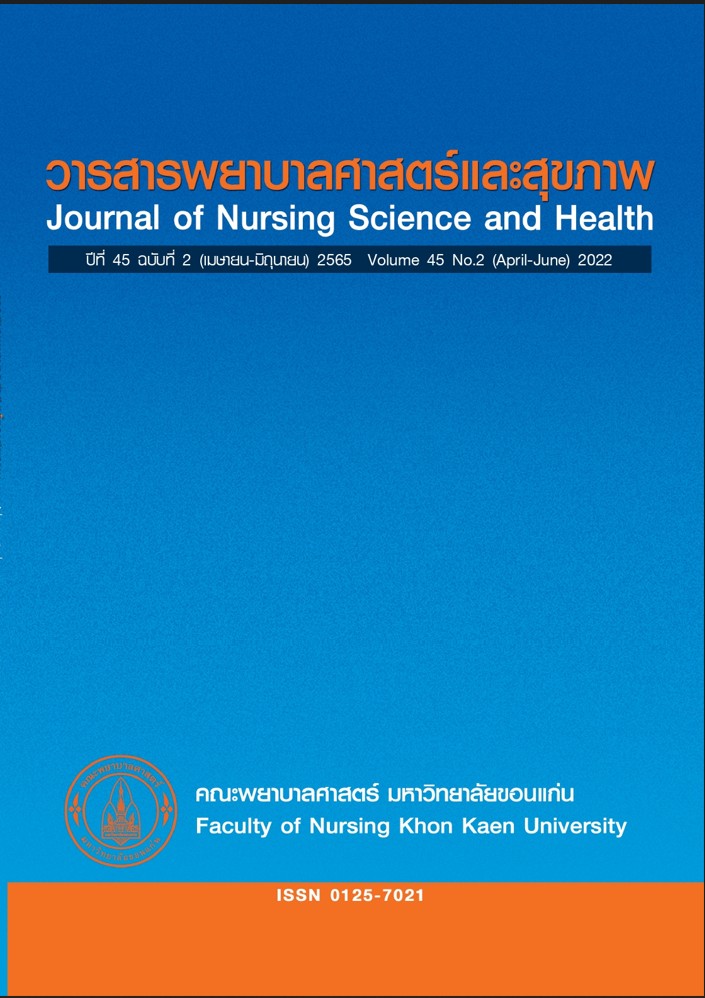บทบาทพยาบาลในการดูแลแบบประคับประคองสำหรับผู้ป่วยเด็กโรคมะเร็งและครอบครัว: กรณีศึกษา โรคนิวโรบลาสโตมา ระยะกลับเป็นซ้ำ
คำสำคัญ:
การดูแลแบบประคับประคองในเด็กและวัยรุ่น, บทบาทพยาบาลดูแลระยะท้าย , โรคนิวโรบสาสโตมาบทคัดย่อ
โรคมะเร็งชนิดนิวโรบลาสโตมาในเด็กเป็นมะเร็งชนิดก้อนที่เกิดจากความผิดปกติของเซลล์ต้นกำเนิดระบบประสาท อาการและอาการแสดงทางคลินิกแตกต่างกันตามตำแหน่ง ขนาดของก้อนมะเร็ง ตำแหน่งของ
การลุกลามของก้อนหรือระยะของโรค ผู้ป่วยเด็กนิวโรบลาสโตมาที่เข้าสู่ระยะสุดท้ายของโรคต้องได้รับการดูแลแบบประคับประคอง ซึ่งพยาบาลมีบทบาทสำคัญในการดูแลในระยะสุดท้ายนี้ บทความนี้นำเสนอความรู้เกี่ยวกับโรคนิวโรบลาสโตมา การดูแลผู้ป่วยเด็กแบบประคับประคอง และบทบาทพยาบาลในการดูแลแบบประคับประคองในผู้ป่วยเด็กโรคมะเร็งนิวโรบลาสโตมาในระยะกลับเป็นซ้ำผ่านกรณีศึกษาที่เข้ารับการรักษาในหอผู้ป่วยเด็ก 1 ราย รับการรักษาในเดือนกุมภาพันธ์ พ.ศ. 2565 และได้รับการดูแลแบบประคับประคองอาการที่สอดคล้องกับมิติปัญหาความต้องการของผู้ป่วยเด็กและครอบครัว
บทความนี้ได้นำเสนอบทบาทพยาบาลในการดูแลผู้ป่วยเด็กนิวโรบลาสโตมาแบบประคับประคองโดยเน้นครอบครัวเป็นศูนย์กลาง ร่วมกับความคิดความเชื่อของครอบครัวเชิงศาสนาและวัฒนธรรมและเชื่อมโยง
กับหน่วยบริการสุขภาพใกล้บ้าน รวมถึงข้อพิจารณาทางจริยธรรมในการดูแลผู้ป่วยระยะสุดท้าย พร้อมทั้งมีข้อเสนอแนะถึงบทบาทพยาบาลในการสนับสนุนประคับประคองครอบครัวผู้ดูแลผู้ป่วยในระยะสุดท้ายด้วย
เอกสารอ้างอิง
World Health Organization. CureAll framework: WHO global initiative for childhood cancer. Increasingaccess,advancingquality,savinglives [Internet]. Geneva: WHO; 2021 [cited 2022May 5]. Available from Licence: CC BY-NCSA 3.0 IGO;https://creativecommons.org/licenses/by-nc-sa/3.0/igo/
Nakagawara A. Asian Pediatric Hematology and Oncology Group (APHOG) and SIOP Asia: Two wheels of a cart. Pediatric Hematology Oncology Journal 2020;5:140–4.
Sangrajrang S, Buasom R. Cancer incidence in Thailand. In: Rojanamatin J, Ukranun W, Supattagorn P, Chiawiriyabunya I, Wongsena M, Chaiwerawattana A, et al., editors. Cancer in Thailand: Xol.X, 2016-2018. Bangkok: Medical Record and Database Cancer Unit; 2021:p.4–68.
Ramathibodi comprehensive cancer center. Cancer report. Bangkok: Mahidol University; 2020:p.3-54.
Lamba N, Groves A, Torre M, Kiat Yeo K, Iorgulescu JB. The epidemiology of primary and metastatic brain tumors in infancy through childhood. J Neurooncol 2022;156(2): 419-29.
He B, Mao J, Huang L. Clinical characteristics and survival outcomes in euroblastoma with bone metastasis based on SEER database analysis. Front Oncol 2021;11:1-6.
Chung C, Boterberg T, Lucas J, Panoff J, Valteau- CouanetD,HeroB, et al. Neuroblastoma. Pediatric blood & cancer 2021;68(2):28473.
Nair M, Thankamony P, Rajeswari B, Chellappan G, Prasanth VR, George PSara, et al. Ten-year experience of treating pediatric metastatic neuroblastoma with chemotherapy-based multimodality approach. Pediatric Hematology Oncology journal 2020;5:39-40.
Wannaphak T. Nursing care for adolescents with cancer relapse receiving palliative care. JNSCU 2019;31(3):1–10. (in Thai)
American Cancer Society. Signs and Symptoms of Neuroblastoma [Internet]. Washington: American Cancer Society; 2021 [updated 2021 April 28; cited 2022 May 5th]. Available from: https://www.cancer.org/cancer/neuroblastoma/detection-diagnosisstaging/signs-and-symptoms.html
Phadungsri P, Ladla A. Development of care model for patients with end stage of cancer: from hospital to home Ubonrat hospital, Khon-Kaen Province. Journal of Nursing and Health Care 2019;37(2):199–207. (in Thai)
Klerlhee T, Wiroonpanich W, Punthmatharith B. Spiritual distress among adolescents with cancer: a qualitative research. SCNJ 2020; 6(2):27-40. (in Thai)
Wannaphak T, Treenai S. Continuing life of adolescents with cancer relapse receiving palliative care. JNSCU 2019;31(1):37-48. (in Thai)
World Health Organization. WHO definition of palliative care [Internet]. Geneva: WHO; 2013 [cited 2022 May 5th]. Available from: http://www.who.int/cancer/palliative/ definition/en.page
The Royal College Pediatricians of Thailand, Pediatric Society of Thailand, Thai Pediatric Oncology Group. Pediatric palliative care. Bangkok: Pentagon advertising limited partnership; 2015. (in Thai)
Sawasdeenarunat V, Taneerat A, Wisettharn T. The development of palliative care model for terminal cancer patients at Maharaj Nakhon Si Thammarat Hospital. NJPH 2015;25(1):144–56. (in Thai)
Prichayudh N, Chatgitisan A, Khunin N, Junda T. Role synthesis of pediatric palliative nurse in Ramathibodi hospital: Document research. JNSU2021;22(42):60-74. (in Thai)
Subwongcharoen N, Chintapanyakun T. Role of palliative care nurses in tertiary hospital. JRTAN 2020;21(1):26–34. (in Thai)
Pathomporn S. Horrattanaruang D, editors. Handbook of palliative and end of life care (Health care provider): Bangkok: The printing office agency to assist veterans in Royal Shupatham; 2020:p.173–84.
Jirakangwan M, Chantree S. The development of palliative care in end of life cancer patients: An integration of caring seamless network at Sisaket hospital. Journal of Nursing and Health Research 2018;19(2):70–83. (in Thai)
Thongjam R, Phrakhrubhavana. Ethics in nursingpractice.JGMCUKK2021;7(1):29-44. (in Thai)
ดาวน์โหลด
เผยแพร่แล้ว
รูปแบบการอ้างอิง
ฉบับ
ประเภทบทความ
สัญญาอนุญาต
ลิขสิทธิ์ (c) 2022 วารสารพยาบาลศาสตร์และสุขภาพ

อนุญาตภายใต้เงื่อนไข Creative Commons Attribution-NonCommercial-NoDerivatives 4.0 International License.
วารสารพยาบาลศาสตร์และสุขภาพเป็นเจ้าของลิขสิทธิ์ในการเผยแพร่ผลงานที่ตีพิมพ์ห้ามผู้ใดนำบทความที่ได้รับการตีพิมพ์ในวารสารพยาบาลศาสตร์และสุขภาพไปเผยแพร่ในลักษณะต่าง ๆ ดังนี้ การนำบทความไปเผยแพร่ออนไลน์ การถ่ายเอกสารบทความเพื่อกิจกรรมที่ไม่ใช่การเรียนการสอน การส่งบทความไปตีพิมพ์เผยแพร่ที่อื่น ยกเว้นเสียแต่ได้รับอนุญาตจากวารสารพยาบาลศาสตร์และสุขภาพ



